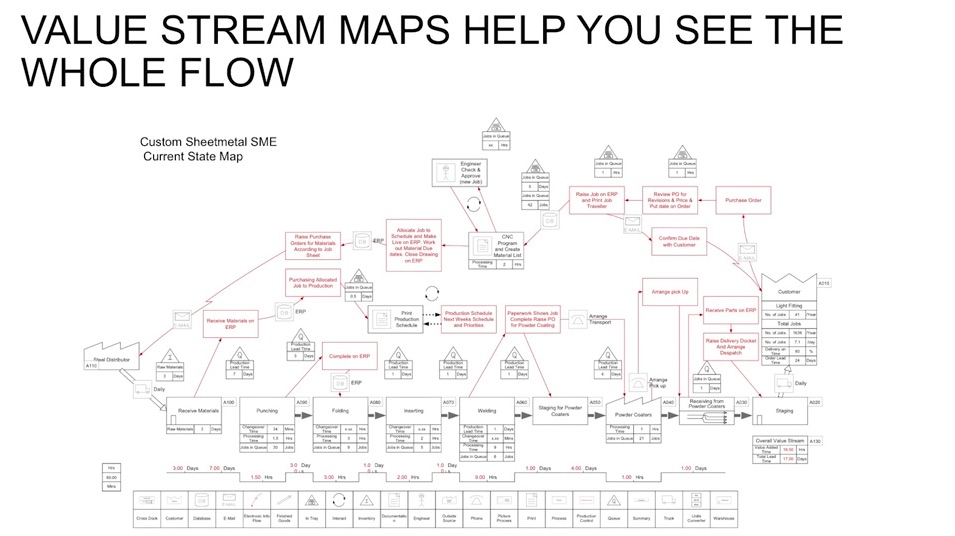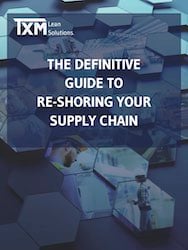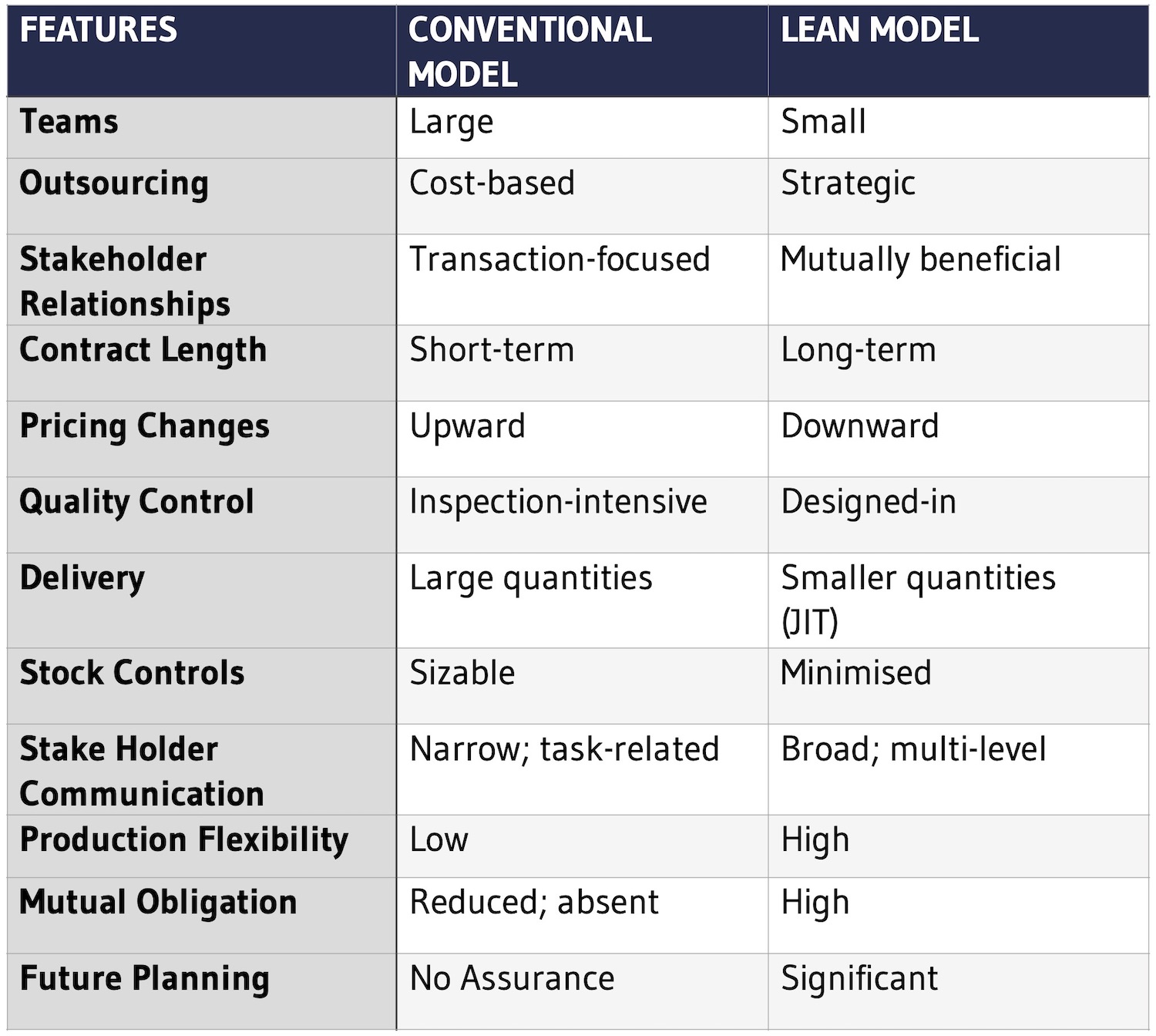Lean Supply Chain Management is a philosophy that champions waste reduction and process simplification. It’s a systematic approach to streamline both material and information flow, ensuring responsive and cost-effective supply chains.
Lean thinking has evolved over the years and whilst Industry 4.0 has been the most recent trend, improving your supply chain using Lean methodologies has become a major focus of businesses.
Many supply chain managers today are looking to build more resilient supply chains to cope with major disruptions including:
- Too much fire fighting and fixing problems.
What Is Lean Supply Chain?
Lean supply chain management is the application of Lean Thinking to the end to end supply chain. Traditionally Lean manufacturing was applied within the four walls of a manufacturing enterprise – from the receiving dock to the shipping dock and everything in between. Lean Supply Chain Management extends the application of Lean upstream into the management of suppliers, downstream in to the management of the distribution network and upwards in to the overall integration and management of the supply chain.
In Lean supply chain management, the focus is on the relentless elimination of non-value added time and consequent reduction of lead time at every step of the supply chain from the manufacturing of raw materials by suppliers to the delivery of finished goods to the end user.
The Four Major Elements of Supply Chain Management
There are four distinct elements that typically make up your Supply Chain. These are Integration, Operations, Purchasing & Procurement and Distribution & Logistics. Lean thinking can be applied to every element.
Integration
Refers to the management of communications and information between the stakeholders in the supply chain. Providing timely and effective interactions across the entire supply chain. Think of it as the brains of the supply chain carrying the messages to every part of the chain. Integrating your supply chain will incorporate some form of technology helping manage and connect the stakeholders of the supply chain.
The integration of your supply chain is responsible for making sure tasks are assigned and completed effectively and timely across your manufacturing processes. Often this means exploring new ways of working and a means to nurture collaboration among departments improving collaboration in turn reduces errors saving time and money. Traditionally supply chain integration is managed by ERP software. Forecasts drive complex plans that are designed to ensure that every step of the supply chain is producing what the next step of the process is expected to need according to the forecast. The failure of this top-down approach is the inevitable inaccuracy of forecasts.
The Lean supply chain management approach uses high level forecasts for medium range planning of resources and capacity. However, day to day and week to week execution is managed by simple tools that respond to the changing needs of customers by “pulling” product through the supply chain as it is required. Making this highly responsive approach work requires lead times to be reduced and suppliers and manufacturers to be near to the customer. As a result, the complex global supply chains many companies have created over the past decade are incompatible with a truly Lean supply chain.
Operations
Maintaining robust supply chain management practices is an important strategy for ensuring efficiency and productivity. The day-to-day operation is the skeleton of the manufacturing processes and where the majority of work is performed. Operations plays a major role in Lean Supply Chain Management monitoring processes and ensuring everything is running smoothly across all functions. Business forecasting is used to predict which supplies will be needed by when and by which process. Business forecasting also predicts the effectiveness of products, strategy and customer experience.
Lean supply chain management brings day to day execution closer to the shop floor. Rather than relying on forecasts, simple tools like Kanban cards and first in first out lanes ensure that operations can respond to changes in customer demand in real time. The result is inevitably more responsive operations, lower inventory and fewer unscheduled product changes.
Purchasing & Procurement
You can’t make something from nothing. Procurement is the process of finding, evaluating and engaging suppliers to supply your business with resources and inputs. Procurement & Purchasing is the respiratory system of the Lean Supply Chain; it makes sure that the right amount of resources is being used at the correct times by the correct departments in the correct places. Procurement creates relationships with suppliers and also identifies the qualities and quantities needed.
The Procurement Department ensures your business has everything required to manufacture a product or deliver a service including materials, supplies, tools and equipment. The Purchasing Department is one of the more critical functions in your supply chain because without the correct purchasing patterns you may find your materials are not available on time, delaying manufacturing production or accumulating excess WIP and Inventory. A balance between supply and demand is critical for businesses to grow, especially globally. In Lean supply chain management, the focus is on collaboration with suppliers. Rather than procurement playing a zero-sum game by constantly seeking lower prices, Lean purchasing involves building long term, mutually respectful relationships with suppliers.
Distribution & Logistics
The supply chain ends with the delivery of your product or service to the customer. Think of the distribution and logistics network as the blood vessels suppling every facet of the Lean Supply Chain with what it needs and when it needs it. Delivering products or service means having a well-thought-out and optimised distribution and logistics network. Distribution and logistics networks must utilise clearly defined lines of communication between all stakeholders to deliver to the customer in a timely fashion.
In a Lean supply chain the focus on reducing lead times leads to shorter, simpler distribution networks. Lean is also applied in warehouses and freight networks to eliminate non-value-added waste such as excessive travel times, waiting times and unnecessary double handling of goods. Lean thinking also challenges assumptions around inventory, leading to lower working capital and smaller warehouses.
The Four Elements Working Together
These four elements of supply chain management must work cohesively for every stakeholders’ benefit. The four elements working together in unison create a synergy that rewards the customer, employees and ultimately the businesses bottom line.
Lean Management Isn’t Just for Manufacturing or Automobiles
Lean Management can be applied across a multitude of industries and is not just for manufacturers or automobiles, it can be used by any businesses wanting to optimise their processes by eliminating waste and non-value-add processes. Businesses can find a number of areas in their supply chains to improve such as time, costs, motion or inventory. Identifying these areas can be done with a Value Stream Map.
What is a Value Stream Map?

Understanding every facet of a business can be undertaken with a Value Stream Mapping session. Value Stream Mapping is an important undertaking of Lean Supply Chain Management regardless of what type of product or service the business is producing. Value Stream Mapping is the process of documenting each step of the business and supply chain. It will want to include every machine used, show where people interact in the business and supply chain including every vehicle movement along the supply chain.
Documenting all the parts of the supply chain requires the creation of a current state map. It identifies all of the wasted processes in the business. Once the current state is mapped it can be used to reorganise the supply chain into the future state. The future state is the ideal state of the supply chain, created by removing waste processes to build the most efficient supply chain.
Eliminating Waste with a Lean Supply Chain
Value Stream Mapping will identify a variety of areas where non-value-added processes can be removed or modified to deliver to the customer with greater agility. Eliminating waste in the supply chain can be achieved by applying the same methodology as Lean manufacturing to achieve as similar result.
The Advantages of Lean Supply Chain Management
The advantages of Lean Supply Chain Management cannot be understated, supply chain complexity has increased in recent years and it is more important than ever to have a concrete supply chain strategy. Lean Supply Chain Management will provide businesses with a competitive advantage over a normal supply chain enabling businesses to respond to market demand and customer needs with greater agility.
Some advantages of the Lean Supply Chain Strategy include:
- Lower Inventory Costs – Reducing the quantities of raw materials, work in progress and finished stock will reduce overall inventory costs.
- Elimination of Waste – As mentioned above the elimination of waste across all functions will have a positive effect on lead times and reduce bottlenecks.
- Increased Productivity & Flexibility – Eliminating waste means you will see increases in productivity, creating greater flexibility to market demands.
- Quality Improvements – Utilising Lean principles allows quality to increase whilst decreasing errors to your customers.
- Employee Morale – When Lean Supply Chains are implemented successfully it will empower employees, boosting morale.
The overall power of Lean Supply Chain Management cannot be accomplished without close relationships based on mutual trust, collaboration and respect. These connections are necessary to ensure that the supply chain stakeholders can service customers and create profitability across all stakeholders.
Features of Lean Supply Chains vs Conventional Supply Chains
There are a number of ways Lean Supply Chains differ from conventional supply chains as outlined in the table below.
Is Your Supply Chain Delivering for Your Business?
- Are your margins being eroded by slow moving stock?
- Do you have crisis contingencies in place?
- Are you finding it hard to predict market demand?
- Need help managing your suppliers?
At TXM we understand the challenges facing businesses of all sizes. Our customised practical solutions are suited to your business and are designed to improve customer service with less waste, less inventory and lower costs.
TXM Article: How to Evaluate Your Manufacturing Supply Chain
TXM Will Lead Your Lean Supply Chain Transformation
TXM have extensive experience in Supply Chain Management. We will map your supply chain, work with your suppliers and ordering systems through to managing your inventory and distributing your products to customers. TXM bring together innovative supply chain solutions for businesses of all sizes.
We have extensive experience & resources across the world working with clients and suppliers to improve overall supply chain performance. Our Lean Supply Chain expertise and innovation has been recognised by global leaders such as AstraZeneca, Kmart Australia, United Technologies Corporation, Schutz AG and ATCO Structures & Logistics.
Useful Links
- The Top 6 Ways to Engage Suppliers to Improve your Supply Chain
- What Makes a Great Supply Chain Manager
- The 5 Benefits of a Lean Supply Chain
- The Top 6 Ways to Build Supply Chain Resilience
- TXM Lean Case Study – Henry Technologies the Lean Warehouse
- TXM Lean Case Study – Improving Supply Chain Performance in Paint Manufacturing
- Read more TXM Lean articles



